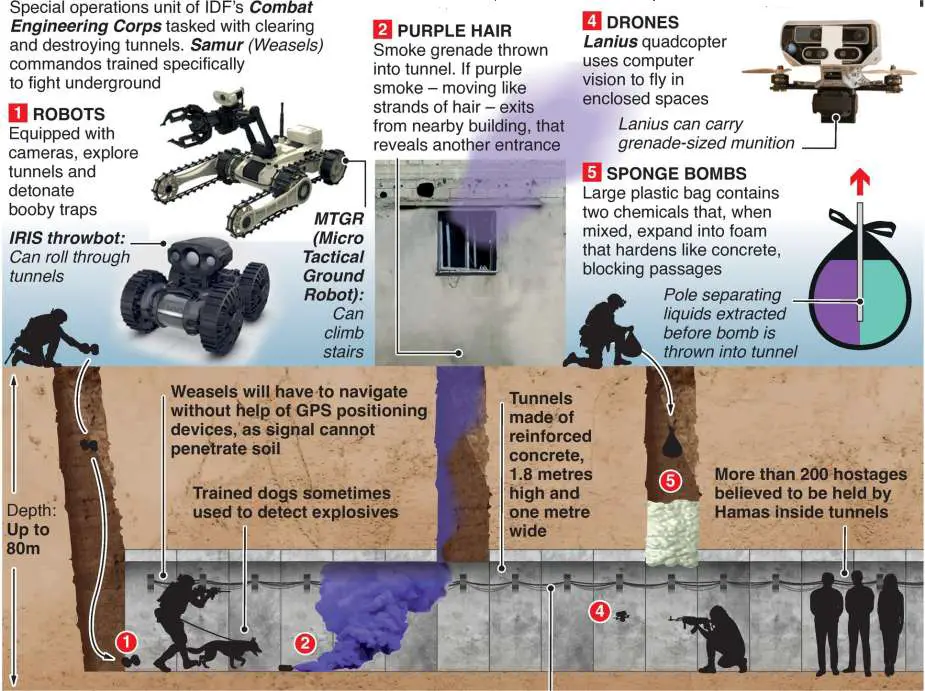- Army
- Conflicts in the world
- Israel - Iran conflict 2025
- Pakistan - India Conflict 2025
- Russia Ukraine War 2022
- Libya conflict day by day
- HAMAS - Israel War 2023
- Operation Serval in Mali French Army
- Sangaris operation Central African Republic
- Sangaris opération militaire République Centreafrique
- Ukraine - Russia conflict
- Syria conflict news
- Defence & Security Industry Technology
- Armies in the world
- Analysis Defense and Security Industry
- Conflicts in the world
- Navy
- Air
Israeli army unveils the secrets of tunnel warfare built by HAMAS
The Israeli Defense Forces (IDF) disclosed on December 17, 2023, their discovery of the most extensive attack tunnel built by Hamas, situated in the northern Gaza Strip near the Erez border crossing. This tunnel, part of a larger network, includes command centers, medical facilities, storage areas, and spaces for manufacturing rockets. The revelation highlights the complexity and sophistication of Hamas's tunnel warfare strategy and the IDF's innovative countermeasures.
Follow Army Recognition on Google News at this link

The Hamas tunnels are one of the most important threats for soldiers of the Israeli Defence Forces. (Picture source Graphic News)
Hamas has designed these tunnels not only for strategic military operations but also for logistical support. The tunnels are equipped with electric wires for telephone and internet, ensuring seamless communication. They are also laced with mines and booby traps, adding a layer of defense against intrusions. Some tunnels are reportedly outfitted with transport rails to facilitate the movement of rockets to launch sites, underscoring the tactical importance of these underground structures.
The tunnels constructed by Hamas in Gaza pose a variety of significant threats to the soldiers of the Israeli Defense Forces (IDF). One of the primary concerns is the potential for ambushes and surprise attacks. These tunnels enable Hamas militants to move undetected, possibly emerging behind or within Israeli lines, leading to surprise attacks. This element of unpredictability makes it challenging for IDF soldiers to anticipate and effectively counter such incursions.
Another major threat is the risk of kidnappings. The tunnels can be used to capture Israeli soldiers, either by dragging them into the tunnels or by enabling militants to infiltrate Israeli territory. Such incidents can have far-reaching strategic and political ramifications.
Moreover, the tunnels are often booby-trapped, making them extremely hazardous for soldiers attempting to navigate or clear them. The presence of explosives, mines, and other improvised explosive devices (IEDs) means that any operation in these tunnels carries a high risk of injury or death.
Additionally, the tunnels may lead to locations of strategic importance, such as weapon storage facilities or command centers. This not only poses a direct threat to Israeli soldiers but also represents a broader security challenge for Israel, as these facilities can be used to orchestrate attacks or store weapons.
The use of civilians in the vicinity of tunnel entrances and exits also complicates IDF operations. The risk of civilian casualties can limit the military's ability to engage aggressively with these targets, often leading to more complex and protracted operations.

To counter the HAMAS tunnel threats, the Israeli Army deploys Special Force Unit YAHALOM using different types of combat equipment. (Picture source Graphic News)
To counter this threat, the IDF has deployed GBU-28 Bunker-Buster bombs. These laser-guided munitions are designed to penetrate the ground before detonation, effectively destroying relatively shallow tunnels. This capability is crucial in neutralizing the more accessible parts of Hamas's extensive tunnel network.
Additionally, the IDF has specialized forces like the YAHALOM unit, a special operations group within the IDF’s Combat Engineering Corps, tasked with the clearance and destruction of tunnels. The Samur (Weasels) commandos, trained specifically for underground combat, play a critical role in these operations.
The confined and claustrophobic environment of the tunnels also presents physical and psychological challenges. Israeli soldiers operating in these conditions must be adept at close-quarters combat and able to maintain their composure in an environment that can be disorienting and stressful.
The IDF YAHALOM units utilize advanced technology to safely navigate and neutralize the tunnels. This includes robots equipped with cameras to explore the tunnels and detonate booby traps. The IDF employs devices like the IRIS throwbot, which can roll through tunnels, and the MTGR (Micro Tactical Ground Robot), capable of climbing stairs.
Furthermore, the IDF uses drones like the Lanius quadcopter, which employs computer vision to navigate enclosed spaces. The Lanius is particularly significant as it can carry grenade-sized munitions, providing a tactical advantage in these confined environments.
The Hamas tunnels represent a multifaceted threat to IDF soldiers, encompassing the risks of surprise attacks, kidnappings, booby traps, access to strategic locations, challenging combat conditions, and the potential for civilian casualties.
The ongoing conflict between Israel and Hamas, with its focus on tunnel warfare, showcases a high-tech arms race beneath the surface. As Hamas continues to evolve its tunnel network, integrating various facilities and defensive measures, the IDF counters with specialized forces and advanced technology. This dynamic reflects the continuous adaptation and escalation in tactics and technology on both sides.
Hamas Israel War 2023


























